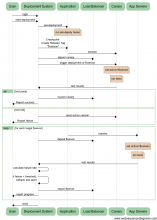Working from the bottom-up we will try to identify the high-level details of a system that would meet the needs of services projects as well as mediawiki and phabricator deployments.
Outcomes
- https://www.mediawiki.org/wiki/Deployment_tooling/Future
- Service Deployment Outline
- Deployment Sequence Diagram:
Some situations that we probably need to explicitly deal with:
- 1 or more (small percentage of) servers fail to respond after some timeout has elapsed
- Retry the deploy on the failed servers
- If still unsuccessful, leave them depooled and raise some alerts about it?
- If the number of unresponsive servers exceeds some small percentage of all targets
- Abort & Roll-back the deployment?
- Cache invalidation. See T99096: Make Varnish cache for /static/$wmfbranch/ expire when resources change within branch lifetime
